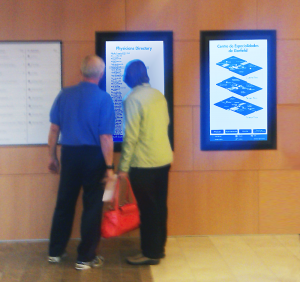Kiosk or Touch screen LCD?
Touch Screen LCD
Here is why:
- A LCD screen is typically larger than the display offered on a kiosk. With a lot of room to play with on a LCD, the content is more spread around, causing it to have a lot more white-space (rest-areas). Without losing a lot of white-space, more content can be offered, causing less-steps to get the directions. Larger is better, friendlier and more effective.
This is also where a lot of graphical designers loose track. They go haywire with this surplus in space and stick it full of content while using every color in the rainbow, nullifying the advantage of a larger screen.
-
A kiosk (with a lot of metal), appears intimidating to some people, causing them to avoid it. Designers of kiosks are getting more and more in tune with the users mindset, making kiosks that are getting less recognizable as ….. kiosks. This however, triggers another downfall of the kiosk. See 6.
-
The location of a kiosk is always a little towards the middle of the area, where an LCD is ‘safely’ located along the wall. Users’ perspective: ‘its bad when you make a fool out of yourself trying to use a system in public, but it is a little less bad if you’re not that wide in the open”.
-
Before there were kiosks and LCD’s, a floor plan of the building was always fixated on the wall. You still see this in a lot of buildings. To a lot of people, that is where a map should be and where they will be looking for it.
Vertical Orientation of the LCD
-
The contents on the LCD, showing the wayfinding application, immediately shows its intend. A kiosk, large screen or not, has some (bulky) equipment distraction causing its true purpose hard to recognize at first sight. Kids will be curious and start hitting buttons and adults already focused their attention as to why they are here, looking for a receptionist.
-
People tend to lean on a kiosk. This is less the case with large screen free-standing kiosks with small or no ledges.
-
Kiosks have more cracks and gaps, places where bacteria will fester. An outdoor, all-weather NEMA 4 compliant kiosk would solve this issue, but they are at least twice as expensive as an indoor kiosk. See ‘Hospital Grade’.
The LCD display also has its cracks but because there is a lot less material, there are less cracks as well. Hospitals, however, do themselves a favor to use Hospital Grade LCD’s, meaning NEMA 4, all weather LCD’s, where there is significantly less chance for bacteria to fester. On the cost aspect: A NEMA 4 LCD is still at least half the investment compared to a NEMA 4 kiosk.
-
LCD Screen is easier to clean. Like wiping off a painting. Now try to get the same image of someone trying to clean a free-standing kiosk.
-
A recessed wall-mounted LCD touch screen blends nicely into the architectural design of the hospital. Even if you have 2 or 3 next to each other. A kiosk does not blend in and is to the architect of the building what adding spices to your food is for the cook. The synergy is ruined.
-
Last but not Least: A LCD display is typically cheaper to buy and to maintain.
I also think that a LCD Screen is easier to make ADA compliant, but maybe this is just my own shortcoming. For ADA compliance details with a LCD touch screen, click here.
If there is no way around it, because there is simply no space on the wall, choose a kiosk with a large screen. These are expensive but you minimize the negative effect as much as possible.
www.here2theresoftware.com
Phone: USA 814 – 342 – 3120
support@here2theresoftware.com

